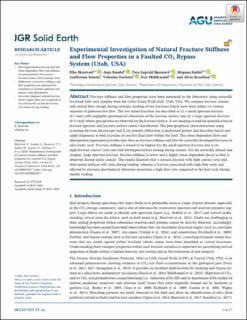Experimental investigation of natural fracture stiffness and flow properties in a faulted CO2 bypass system (Utah, USA)
Skurtveit, Elin; Sundal, Anja; Bjørnarå, Tore Ingvald; Soldal, Magnus; Sauvin, Guillaume; Zuchuat, Valentin; Midtkandal, Ivar; Braathen, Alvar
Peer reviewed, Journal article
Published version
Permanent lenke
https://hdl.handle.net/11250/2689389Utgivelsesdato
2020Metadata
Vis full innførselSamlinger
- NGI articles [1061]
Sammendrag
Fracture stiffness and flow properties have been measured in the laboratory using naturally fractured fault rock samples from the Little Grand Wash fault, Utah, USA. We compare fracture closure and related flow change during isotropic loading of two fractures which have been subject to various amounts of paleo‐reactive flow. The two tested fractures are described as (i) a small‐aperture fracture (0.1 mm) with negligible geochemical alterations of the fracture surface and (ii) a large‐aperture fracture (0.53 mm) where precipitates are observed on the fracture surface. X‐ray imaging is used for quantification of fracture aperture and fracture surface contact distribution. The petrographical characterisation using scanning electron microscopy and x‐ray powder diffraction is performed pre‐test and describes burial and uplift diagenesis as well as pulses of reactive fluid flow within the fault. The stress dependent flow and deformation experiment provides new data on fracture stiffness and flow for naturally developed fractures in siliciclastic rock. Fracture stiffness is found to be highest for the small‐aperture fracture due to its high fracture contact ratio and well‐developed surface mating during closure. For the naturally altered and rougher, large‐aperture fracture, fracture stiffness is lower and a highly stress dependent decay in flow is observed during initial closure. The results illustrate that a natural fracture with high contact ratio and well mated surfaces will close during loading, whereas a fracture associated with high flow rates and affected by previous geochemical alteration maintains a high flow rate compared to the host rock during similar loading. Experimental investigation of natural fracture stiffness and flow properties in a faulted CO2 bypass system (Utah, USA)
